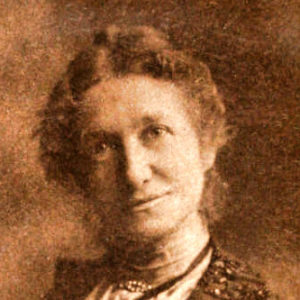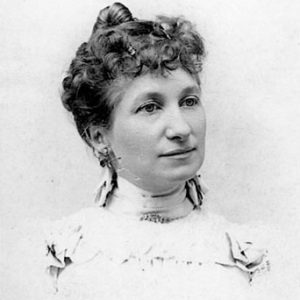calsfoundation@cals.org
Annie Schoppach (1858–1949)
aka: Annie Adelia Anette Ryerse
Annie Schoppach was the first female graduate of the Medical Department of the University of Arkansas (now the College of Medicine of the University of Arkansas for Medical Sciences). She practiced medicine in Little Rock (Pulaski County), entering a profession that was almost entirely male dominated.
Annie Adelia Anette Ryerse was born in Port Ryerse, Ontario, Canada, on May 3, 1859, the daughter of James and Sarah Ryerse. The Ryerse family was the most prominent family in the area, her great-grandfather having been the lieutenant governor of the Western District of Upper Canada. She experienced a great deal of loss early in her life. Her mother died when she was a small child. Later, her twin sister died. Her paternal grandfather, maternal grandparents, and her father all died when she was still in her teens. All of these deaths may have influenced her choice to enter the medical profession. Also, her paternal grandfather was Reverend George J. Ryerse, who mixed his Baptist ministry along the north shore of Lake Erie with his medical practice. She is said to have diligently read his medical books with great interest.
In 1878, she married James Cutting, a storekeeper and businessman of Port Ryerse. This marriage produced two surviving children, Ada and Herwald. Sometime in 1883 or 1884, her marriage to Cutting ended, and she left for the United States, taking Herwald with her but leaving Ada with her father. She settled in Michigan, where several siblings lived. She worked as a schoolteacher, as noted on the marriage license to her second husband. There are no records about her secondary or university education.
In 1896, she met and married James Shoppach in Michigan, who was visiting there at the time. Shoppach was a prominent public servant in Little Rock, descended from the Shoppach family in Benton (Saline County). She moved to Little Rock with her new husband and son in 1895, and by 1897, she was admitted to medical school Although no record exists of her education, she must have convinced the faculty of the medical school that she could surmount the rigors of medical education. Also, her husband was well connected. She became the first woman to graduate from the Medical Department of the University of Arkansas.
(Later, in all her advertisements and in her obituary, her name was spelled “Schoppach” rather than “Shoppach,” the family name of her second husband. Schoppach was the original name of her husband’s ancestors who emigrated from Germany, though the “c” was lost over time. Perhaps she felt that the name should be spelled in the original German way, or perhaps she wished later to distance herself from her second husband by adopting the spelling containing the “c.”)
There are several stories of how Schoppach was harassed by her fellow students. But she was determined, and despite being snubbed and not well accepted, she overcame all difficulties. The most egregious story coming through family lore was one that occurred in the anatomy laboratory. One of the fellow students cut off part of a male cadaver and placed it in her purse. Nonetheless, she graduated with her class of twenty in 1901.
Schoppach initially opened her office at 404½ Main Street in Little Rock. She purchased a house at 1401 S. State Street, which was her home, office, and maternity hospital for the rest of her life. Her time was largely spent with maternity cases.
Schoppach left her second husband sometime before 1908. The 1908 City Directory and others following it had them living apart after that time. There is no record of her having divorced either husband, and she is not mentioned in either the obituary of James Cutting or of James Shoppach.
Schoppach served the women of Little Rock well, rich and poor alike. She is said to have used income from her white patients to finance the care of black patients who had little money. She was not a member of the Arkansas Medical Society (except for a short time in 1904) or the Pulaski County Medical Society. Neither was she on the staffs of the Arkansas Baptist Hospital or St. Vincent Infirmary. This was perhaps by choice, to preserve her independence.
Schoppach’s son, Herwald Cutting, also entered the University of Arkansas Medical Department, matriculating in 1908, at his mother’s urging. He graduated in 1912 as president of his class. He opened an office on Victory St., but he, like his mother, soon centered his activities around the house at 1401 S. State Street. His practice also dealt primarily with maternity cases.
Schoppach continued her medical practice until the age of eighty-five. She died on November 9, 1949, and her body was cremated. Herwald Cutting died on March 10, 1953. He, his wife Francis Babcock Cutting, and his mother’s ashes are interred in Oakland Cemetery in Little Rock. A large monument was placed there in 2006 to honor all three.
For additional information:
Baird, W. David. Medical Education in Arkansas, 1879–1978. Memphis: Memphis State University Press, 1979.
Brooks, Jim. “Woman declared medical pioneer.” Arkansas Democrat-Gazette. September 10, 2007, p. 1B, 6B.
Clark, Richard B., Sharon Keel, and Amanda Saar. “Dr. Annie Schoppach: First Female Graduate of UAMS.” Pulaski County Historical Review 53 (Winter 2005): 106–111.
Obituary of Dr. Annie Schoppach. Arkansas Gazette. November 10, 1949, p. 6.
Obituary of Dr. Herwald Cutting. Arkansas Gazette. March 11, 1953, p. 12A.
“Woman Graduated: Members of University of Arkansas Medical Class.” Arkansas Gazette. April 13, 1901, p. 5.
Richard B. Clark
University of Arkansas for Medical Sciences
 Annie Schoppach
Annie Schoppach  Annie Schoppach
Annie Schoppach 




Comments
No comments on this entry yet.